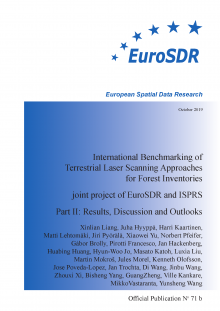Official Publication No. 71 - Part 2 (2019)
The past two decades have witnessed tremendous research efforts and significant progress in the application of terrestrial laser scanning (TLS) in forest inventories. To clarify the strengths and weaknesses of TLS as a measure of forest digitization, as well as the capability of recent algorithms to extract attribute of trees in forests, an international benchmarking of TLS approaches for forest inventories was launched in 2014 by the European Spatial Data Research Organization (EuroSDR) and coordinated by the Finnish Geospatial Research Institute (FGI). Twenty-four groups worldwide initially indicated that they would participate, and eighteen groups successfully processed the data and submitted their results for evaluation. Partners processed identical TLS datasets and delivered a common set of results, including the digital terrain model (DTM), the tree map, the tree height, the diameter at the breast height (DBH) and the stem curve of each individual tree at the plot level. In addition, the stem volume and tree biomass were calculated based on these parameters and on local allometric models. The outcomes from the partners were evaluated with a standard evaluation procedure. This paper reports the results of this benchmarking project and discusses the findings, which clarify the status quo of TLS-based forest investigations. With single-scan data, i.e., one hemispherical scan per plot, most of the recent algorithms are capable of achieving stem detection with approximately 75% completeness and 90% correctness in the easy forest stands (easy plots: 600 stems/ha, 20 cm mean DBH). The detection rate decreases when the stem density increases and the average DBH decreases, i.e., 60% completeness with 90% correctness (medium plots: 1000 stem/ha, 15 cm mean DBH) and 30% completeness with 90% correctness (difficult plots: 2000 stems/ha, 10 cm mean DBH). The application of the multi-scan approach, i.e., five scans per plot at the center and four quadrant angles, is more effective in complex stands, increasing the completeness to approximately 90% for medium plots and to approximately 70% for difficult plots, with almost 100% correctness. The results of this benchmarking also showed that the TLS-based approaches can provide the estimates of the DBH and the stem curve that are close to what is required in practical applications, e.g., national forest inventories (NFIs). In terms of algorithm development, a high level of automation is a commonly shared standard, but a bottleneck occurs at stem detection and tree height estimation, especially in multilayer and dense forest stands. The greatest challenge is that even with the multi-scan approach, it is still hard to completely and accurately record all trees in a plot due to the occlusion effects of the trees and bushes in forests. Future development must address the redundant yet incomplete point clouds of forest sample plots and recognize trees more accurately and efficiently. It is worth noting that TLS currently provides the best quality terrestrial point clouds in comparison with all other technologies, meaning that all the benchmarks labelled in this paper can also serve as a reference for other terrestrial point clouds sources.

